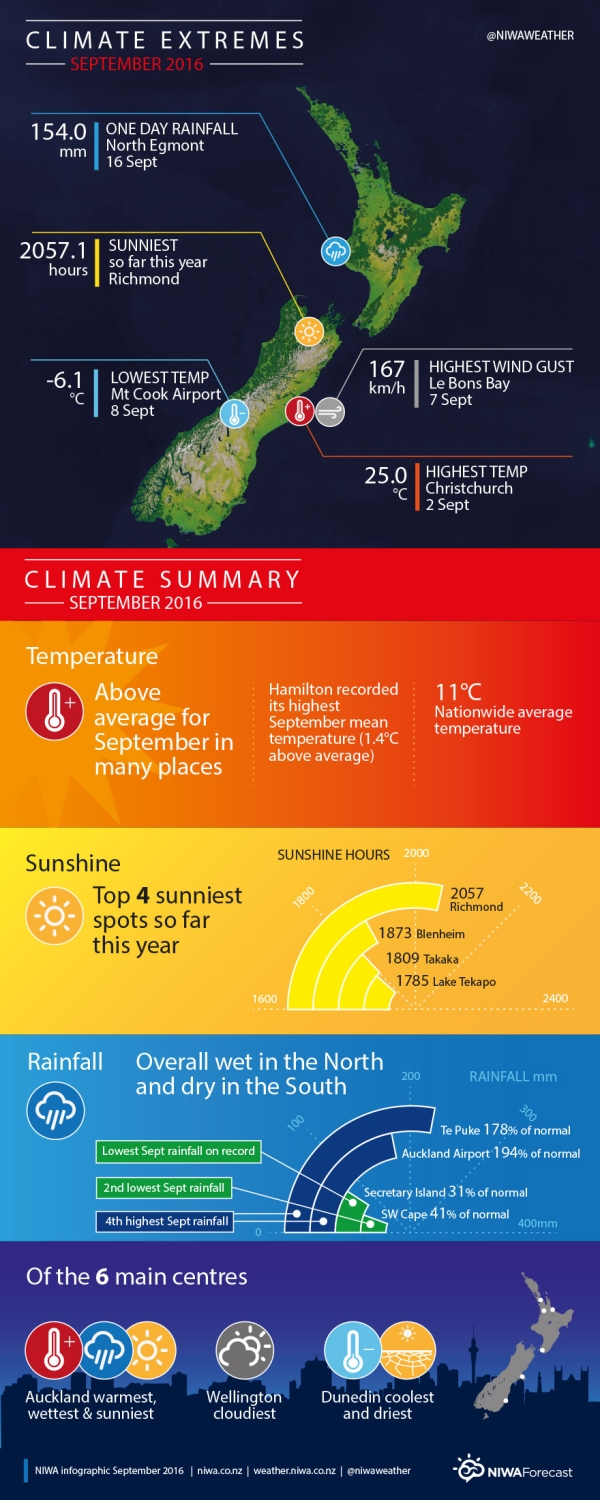A wet month for the North Island, dry for the South Island, and warm almost everywhere.
|
Rainfall
|
September rainfall was generally above normal (120-149%) or well above normal (> 149%) for much of the North Island, particularly in Auckland, Bay of Plenty, Gisborne, Hawke’s Bay and Wellington, but below normal (50-79%) or well below normal (< 50%) for much of the South Island, particularly in Otago and Southland. An exception for the North Island was in Manawatu where rainfall was below normal. |
|
Temperature |
September temperatures were above average (+0.50°C to +1.20°C) or well above average (< +1.20°C) throughout most of New Zealand. Eastern coastal margins of both islands, the north of the South Island and western Northland and Auckland recorded near average temperatures (-0.50 to 0.50°C). |
|
Sunshine |
September sunshine was below normal (75-89%) or well below normal (< 75%) for most of the North Island, whereas sunshine was near normal (90-110%) for most of the South Island. Well above normal (> 125%) sunshine was observed in some central and western areas of the South Island. |
|
Soil Moisture |
At the end of September 2016, soil moisture levels were much lower than normal for the time of year across middle and northern Canterbury as well as coastal Wairarapa, and slightly lower than normal for southern Canterbury, north Otago and parts of Southland. Soil moisture levels were above normal for the time of year for eastern Gisborne and Hawke’s Bay, and near normal for the remainder of the country. |
Overview
During September 2016, mean sea-level pressures were higher than normal over and to the south of New Zealand, and near normal to the north of the country. This pressure pattern resulted in a prevalence of winds from an easterly direction.
Temperature mostly above average
September temperatures were above average (+0.51°C to +1.20°C) or well above average (> +1.20°C) throughout most of New Zealand. Due to the prevailing easterly air flow over New Zealand for September, eastern coastal margins of both islands did not observe warm temperatures to the same extent as most other parts of the country – these areas recorded near average temperatures for the month (-0.50°C to 0.50°C). The north of the South Island and western Northland and Auckland also recorded near average temperatures.
The nationwide average temperature in September 2016 was 11.0°C. This is 0.43°C above the 1981-2010 September average from NIWA’s seven station temperature series which begins in 1909. (N.B. this is an interim value: Dunedin - one of the seven stations - missing 3 days.)
Wetter in the north but no storms and drier in the south
The succession of several low pressure systems and prevalence of winds from an easterly direction contributed to wetter than usual conditions for much of the North Island, especially in the east. Some parts of Auckland and the Bay of Plenty received nearly double their normal September rainfall, and many other locations recorded well above normal (> 149%) or above normal (120-149%) rainfall. One particularly intense storm affected the Kapiti Coast, causing Paraparaumu to receive 115 mm, or 134% of its normal September rainfall, over just two days (16-17 September). Over the month as a whole, more than double the normal September rainfall (216%) was recorded at Paraparaumu. However, it was a drier month for the South Island due to high pressure persisting over the Island and blocking the passage of the storms in the north. Most locations recorded below normal (50-79%) or well below normal (< 50%) rainfall totals for September. It was an especially dry month for Timaru, which recorded only 6 mm of rainfall for the entire month, a mere 17% of normal September rainfall for that location.
At the end of September 2016, soil moisture levels were much lower than normal for the time of year across middle and northern Canterbury as well as coastal Wairarapa, and slightly lower than normal for southern Canterbury, north Otago and parts of Southland. Soil moisture levels were above normal for the time of year for eastern Gisborne and Hawke’s Bay, and near normal for the remainder of the country.
Cloudy skies associated with the higher than normal rainfall totals meant that September sunshine was below normal (75-89%) or well below normal (<75%) for most of the North Island. However, sunshine was near normal (90-110%) for most of the South Island. Well above normal (>125%) sunshine was observed in some central and western areas of the South Island.
Climate summary infographic for September 2016
Downloads
Download the September 2016 Monthly Climate Summary [PDF 600KB]
Download the September 2016 climate summary infographic [PDF 260KB]
Climate Statistics for September 2016 [PDF 81KB]
Further highlights
- The highest temperature was 25.0 °C, observed at Christchurch (Riccarton) on 2 September.
- The lowest temperature was -6.1 °C, observed at Mt Cook Airport on 9 September.
- The highest 1-day rainfall was 154 mm, recorded at North Egmont on 16 September.
- The highest wind gust was 167 km/hr, observed at both Le Bons Bay (Banks Peninsula) and Akitio (Tararua District) on 7 September.
- Of the six main centres in September 2016, Auckland was the warmest, wettest and sunniest, Dunedin was the coolest and driest, and Wellington was the cloudiest.
- Of the available, regularly reporting sunshine observation sites, the sunniest four locations in 2016 so far (1 January – 30 September) were Richmond (2057 hours), Blenheim (1873 hours), Takaka (1809 hours) and Lake Tekapo (1785 hours).
Contacts
For further information, please contact:
Mr Chris Brandolino Principal Scientist – Forecasting, NIWA National Climate Centre Tel. 09 375 6335, Mobile 027 886 0014
For climate data enquiries, please contact:
Mrs Petra Pearce Climate Scientist, NIWA Auckland Tel. 09 375 2052

